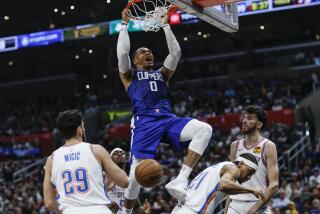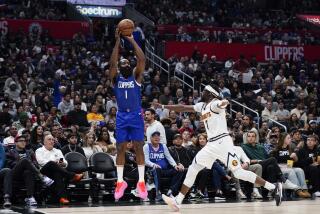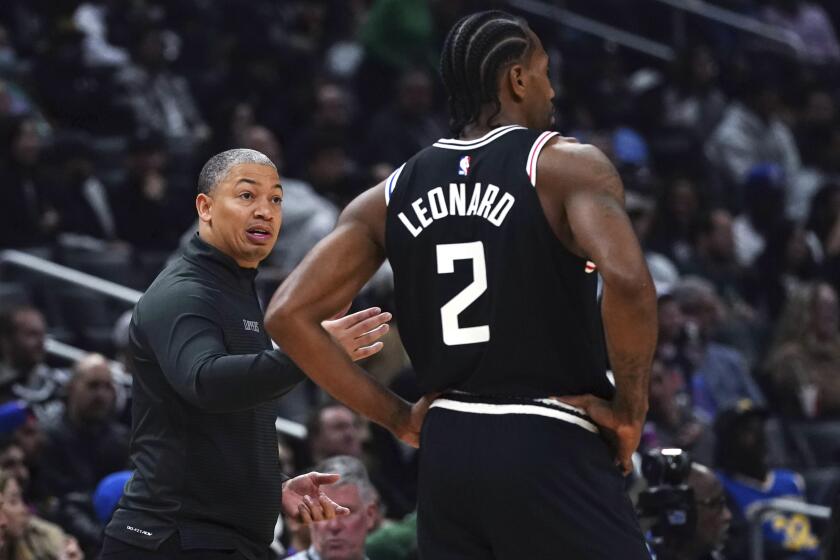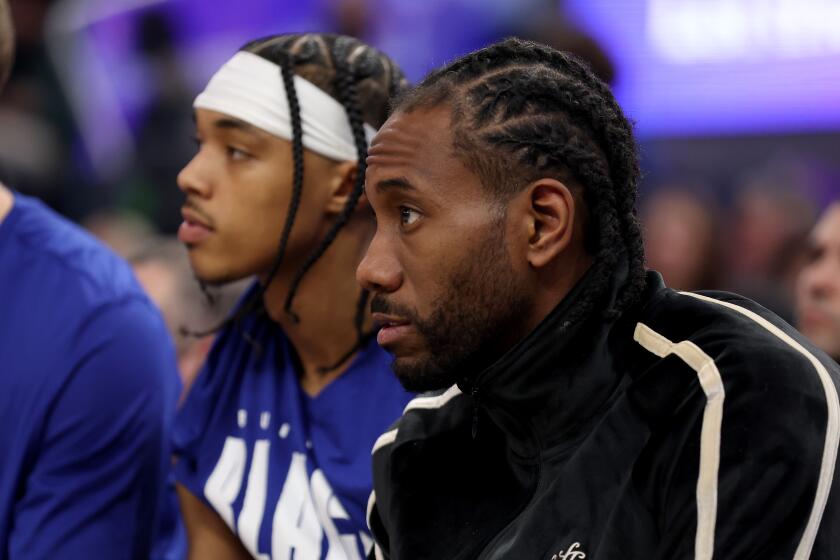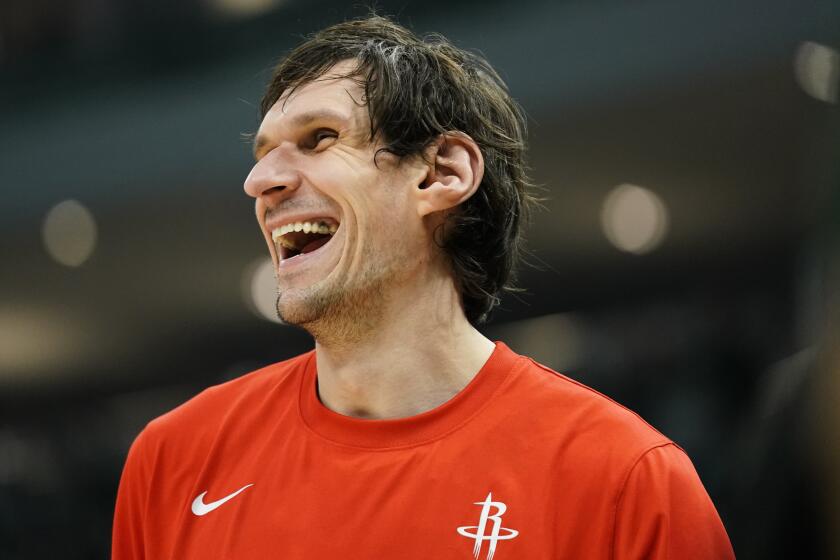Amid L.A.’s civil strife in 1992, the Clippers found a way to host a crucial playoff game
National Guard troops patrolled the streets on the day the game was supposed to be played.
A dense, dark haze drifted overhead as hundreds of fires burned and thousands of looters rampaged across the city.
Basketball did not seem so important.
It was the spring of 1992 and the NBA playoff series between the Clippers and the Utah Jazz was abruptly interrupted — like the rest of normal life in Los Angeles — by widespread rioting.
With the Sports Arena perched at the edge of a violence-racked neighborhood, Game 4 was postponed and, back in New York, league officials wanted to shift the series out of town, perhaps to Las Vegas.
Twenty-five years later — as the teams meet again in the postseason — memories of that time remain vivid for a few people in the Clippers organization.
A front-office executive recalls the frantic search for an alternate playing site, officials wondering if they could sneak back into the Sports Arena to pack up their blue-and-red-adorned hardwood floor. And maybe grab some towels and Gatorade.
Doc Rivers, now the Clippers coach, was a veteran guard for the team then. He remembers that players had a more immediate concern.
“We couldn’t find anywhere to practice,” he says. “It was crazy.”
::
No one expected much from the Clippers at the start of the 1992 playoffs.
Even with Danny Manning, Ron Harper and Charles Smith in the lineup, they did not appear to match up with a Utah team that featured two future Hall of Famers in Karl Malone and John Stockton. The Jazz won the first two games handily.
But when the best-of-five series moved to Los Angeles on April 28, the Clippers swung the momentum with a 98-88 victory.
“This shows us that we are getting better through the playoffs,” Smith said. “We’re making some gradual changes from the first games to now, and that will only help us in the next games.”
The next day, a jury acquitted four Los Angeles police officers of all charges except for one count of excessive force in the beating of Rodney G. King.
The angry response began about three miles from the Sports Arena, at the intersection of Florence and Normandie avenues, where a truck driver named Reginald Denny was pulled from his rig and beaten nearly to death.
Rioting spread quickly throughout the city. Officials reported about 1,000 structural fires, 23 deaths and almost 600 injuries in a little more than 24 hours.
Players watched the upheaval on television.
“I’m used to going to the video store and getting a video and seeing that kind of stuff,” Malone told The Times then. “It was incredible and it was sad.”
There was no way to play Game 4 on Thursday, April 30, with the city under dusk-to-dawn curfew. The Lakers, facing the Portland Trail Blazers in another playoff series, chose to continue in Las Vegas and NBA officials wanted the Clippers to do likewise.
Jazz executives presented another option — the game could be moved to their arena in Salt Lake City with revenues paid to the Clippers organization. But Clippers executives were thinking about more than finances.
Amid the chaos, they were trying to maintain at least some focus on basketball.
“Talking with everybody on our leadership staff, we didn’t want to lose that game,” says Carl Lahr, a senior vice president for the team. “We knew that to beat the Jazz, we’d need that home-court advantage.”
Pauley Pavilion was big enough, but the city could not spare any policemen to work the game. Long Beach Arena was crossed off the list when rioting spread southward to that community.
Bren Events Center at UC Irvine was safe but only one-third the size of the 15,000-seat Sports Arena. With the league pressuring for a decision, the Clippers kept looking.
“We had to throw this thing together in a really short amount of time,” Lahr says.
The players, meanwhile, remained in a state of limbo.
The Clippers moved their practices to a local high school, Rivers says. The Jazz did the same, working out at Inglewood High with the gym doors locked and security stationed outside.
Drills came to a brief halt when players smelled smoke and heard sirens. The team considered flying back to Utah.
“We talked about it but just did not feel it was the right thing to do,” coach Jerry Sloan said at the time. “We’re here and didn’t want to have to go home and then almost turn right around and come back.”
::
The Anaheim Convention Center had some history with the sport of basketball.
The Amigos, a team from the defunct American Basketball Assn., had played there during the late 1960s before relocating to — of all places — Utah. In 1989, a local high school league played four games at the 7,400-seat venue.
NBA officials wanted the series to resume by Saturday, May 2, to accommodate network television. The Clippers needed more time and insisted on a Sunday afternoon slot.
“The NBA had somebody on site,” Lahr says. “He was able to assure the league, ‘Hey, they can pull this off.’”
It wasn’t easy.
Though the Sports Arena was losing a significant amount of money on the switch, venue staff pitched in, showing up for work in what looked like a war zone with National Guard troops all around.
The wooden floor was pulled up and loaded onto a truck. Workers grabbed the baskets and signage and padded bench seats.
“We had to remember everything,” Lahr says. “Do we have towels? Do we have Gatorade?”
At the same time, the Clippers sales staff convened in a room at the Anaheim Convention Center, hunkering down at a long table to call as many season-ticket holders as possible.
Bring your Sports Arena ticket to Anaheim, fans were told. First come, first served.
With 11,000 tickets sold for Game 4, there would not be enough seats for everyone. The NBA insisted upon an adjacent viewing room with televisions.
The riots were subsiding by then, but Los Angeles was still in disorder, so team officials had a very different concern. Lahr recalls: “What would happen if only 500 people showed up?”
::
On Sunday, May 3, National Guardsmen shot and killed a motorist who allegedly tried to run them over. Still, then-Mayor Tom Bradley declared the crisis was over.
An hour south, nervous Clippers executives walked outside the convention center wondering what they might find.
“It was a huge line,” Lahr says. “We went out there and were talking to people and shaking peoples’ hands.”
The crowd streamed inside. Fans with courtside tickets at the Sports Arena? Those with seats in the nose-bleed sections? It didn’t matter — on that day, everyone was equal and racing for the best spots.
“Once you got your seat, you didn’t want to get out,” Lahr says. “Nobody wanted to go to the bathroom because somebody else would grab their seat.”
The Clippers trotted out for warmups, surprised to see the place transformed into a reasonable, if half-sized, facsimile of their home arena.
Pregame introductions drew a standing ovation. It was the beginning of a raucous afternoon, the crowd of about 7,100 sounding as loud as anything the team had heard at the Sports Arena.
Not even an electrical failure in the first quarter, which forced officials to use a hand-held air horn instead of the venue’s buzzer, could dampen spirits.
“If I could have hoped,” coach Larry Brown said at the time, “I would have hoped for this.”
With the score close and less than 2 minutes remaining, Manning made two free throws and Smith scored on a layup. Rivers — providing the postseason leadership the team had needed — weaved into the lane and flipped a shot into the air.
The ball hung on the rim a moment before dropping in.
The Clippers ultimately outscored Utah 11-2 in those final moments to cement a 115-107 victory.
“We weren’t supposed to get to a Game 5,” Manning said. “But anyway, we’re here. And we won’t go away.”
In the end, there would be no fairy-tale ending for the Clippers, who lost the decider in Salt Lake City the following night. Rivers doesn’t like to talk about that.
But ask him about that afternoon in Anaheim so long ago and a smile crosses his face. He wonders if it meant something a little bit more.
“It was like, for the people of L.A., the first time they could come out of their houses and rejoice,” he says. “I remember that.”
Follow @LAtimesWharton on Twitter
More to Read
Get our high school sports newsletter
Prep Rally is devoted to the SoCal high school sports experience, bringing you scores, stories and a behind-the-scenes look at what makes prep sports so popular.
You may occasionally receive promotional content from the Los Angeles Times.


